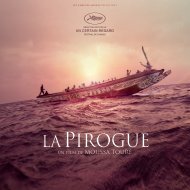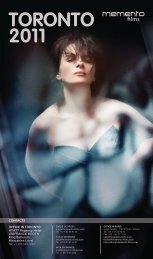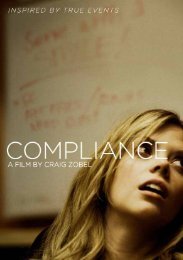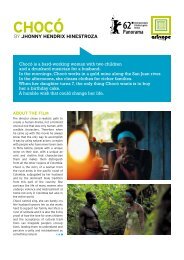BY JÃRÃME DE MISSOLZ - Memento Films International
BY JÃRÃME DE MISSOLZ - Memento Films International
BY JÃRÃME DE MISSOLZ - Memento Films International
You also want an ePaper? Increase the reach of your titles
YUMPU automatically turns print PDFs into web optimized ePapers that Google loves.
KIDS<br />
OF<br />
TODAY<br />
<strong>BY</strong> JÉRÔME <strong>DE</strong> <strong>MISSOLZ</strong><br />
FROM AN ORIGINAL I<strong>DE</strong>A <strong>BY</strong> JEAN-FRANÇOIS SANZ
A legendary rock critic from the 70s takes possession of a bunch<br />
of young clubbers. From Paris to Beijing, via New York, Montreal<br />
and Hong Kong, a dream-wave breaks across their lives generating<br />
a series of William-Burroughs-style cut-up scenes in which<br />
sensuous past and urban future are plaited together in musical<br />
patterns like serpents’ skins.<br />
KIDS<br />
OF<br />
TODAY<br />
LOVE STREAMS AGNÈS B PRODUCTIONS PRESENTS<br />
A FILM <strong>BY</strong> JÉRÔME <strong>DE</strong> <strong>MISSOLZ</strong><br />
BASED ON AN ORIGINAL I<strong>DE</strong>A <strong>BY</strong> JEAN-FRANÇOIS SANZ<br />
FRANCE / 2011 / 97’<br />
Night brings freedom. Antoine, Aurélie, Mathieu, Riposte and<br />
Sabine have all come up to Paris to escape provincial drudgery.<br />
They organize amateur tattoo nights on the club circuit, play<br />
in noisy bands, run a semiotic magazine, spend drowsy days adrift<br />
on a sea of Facebook screens.<br />
The stranger calls himself 69-X-69, executor of the last will<br />
and testament of Yves Adrien, rock critic, early user of the term<br />
punk, inventor of növo, chronicler of the heyday of Paris glam, when<br />
the Palace club was the crucible from which Gaultier and Mugler<br />
sprang. Yves Adrien staged his own death in the Seychelles<br />
in 2001.<br />
With his giant fur hat, hair down to his bum, his fondness for<br />
expensive wines, adulation of the Virgin Mary and addiction to girls<br />
thirty years younger than himself, this stranger is his own<br />
doppelganger, fake executor, real-life vampire, ludicrous by day,<br />
captivating by night when his skeletal form starts to dance to<br />
the sound of Crystal Castles.<br />
KIDS OF TODAY is a documentary. Nothing is invented.<br />
As the movie progresses though, reality morphs into drama,<br />
upsetting every known rule of story-telling, every known rule<br />
of movie-making.<br />
Super 8 from 1979 and 1980 combines with TV news footage from<br />
the period, punk graphics, present-day I-phone clips, contemporary<br />
stills-camera memory stick and HDV images, producing a plunge<br />
into the electronic whirlpool, many of whose tenets and premises<br />
were anticipated in the cold wave years when the last analogue<br />
generation was inventing a future now come true.<br />
The film shuttles between past and present nights, making thought<br />
sexual.<br />
Girls and boys of from a post-punk past wander through presentday<br />
nights like withered ghosts, unable to live, unable to die in the<br />
darkness of our pixellated cities. And the tears stream down their<br />
cheeks as they turn human at last.<br />
SYN<br />
OPS<br />
IS<br />
Love Streams agnès b. Productions<br />
17, rue Dieu - 75010 Paris - France<br />
+33 1 53 38 43 45<br />
lovestreams@agnesb.fr<br />
www.lovestreams.fr<br />
WORLD SALES AND FESTIVALS<br />
<strong>Memento</strong> <strong>Films</strong> <strong>International</strong><br />
9, cité Paradis - 75010 Paris - France<br />
+33 1 53 34 90 20<br />
sales@memento-films.com<br />
festival@memento-films.com<br />
www.memento-films.com<br />
FRENCH PRESS<br />
Annie Maurette<br />
+33 6 60 97 30 36<br />
annie.maurette@gmail.com<br />
INTERNATIONAL PRESS IN CANNES<br />
Stanislas Baudry<br />
+33 6 16 76 00 96<br />
sbaudry@madefor.fr
KIDS OF TODAY opens with an extract from German<br />
silent movie classic The Cabinet of Dr Caligari,<br />
quick cutting to clips from Canadian electro-punk band<br />
Crystal Castles. For a couple of nano-seconds, it seems<br />
like we’re in for yet another coked out rockumentary.<br />
But no.<br />
Starting out with a voyeuristic interest in the fools’<br />
paradise of sex and drugs and rock and soul – most<br />
especially an ironic fondness for the split-crotch<br />
transgressions of the underground scene – Jérôme<br />
de Missolz soon finds himself shuttling back and forth<br />
between archive material from the late seventies and<br />
a depiction of Paris’ current night-time counterculture.<br />
TR<br />
DUC<br />
ION<br />
KIDS OF TODAY is a documentary of sorts, a movie<br />
about the digital age. It takes a bunch of young<br />
clubbers in today’s Paris and watches as, gradually,<br />
they are possessed by a ghost from the past, a rock<br />
critic of the seventies named Yves Adrien, a.k.a 69-X-<br />
69, who says he is dead – the better to feed on<br />
this tender prey.<br />
Legendary Rock critic, Yves Adrien is the creator<br />
of innumerable avatars. Early user of the term punk<br />
back in 1973, inventor of the term Novö on a bender<br />
with Iggy Pop in 1979 he claims the truth about<br />
Facebook in the room where Oscar Wilde died almost<br />
exactly one hundred years ago.<br />
Mathieu and Bench, Riposte, Sabrina and Antoine want<br />
fame. They run a club-night tattoo outfit, a semiotic<br />
fanzine, a band called This is Pop. They make musical<br />
instruments out of plastic toys, hold all night after<br />
parties, flit from cybernetic seminars to openings and<br />
straight or gay, they live by night, spending their days<br />
surfing the Internet in the cellars and bedsits<br />
they inhabit. At the touch of a trackpad, instantly<br />
they access everything they think they need to know.<br />
With one click of their smartphones, they immortalize<br />
and disseminate every scrap of experience. Everything<br />
they do is advertised as soon as it is done. As the ghost<br />
of Yves Adrien comes into their lives, they learn<br />
to contemplate their own desires in the looking-glass<br />
of a previous age, when synthesized sound and gloomy<br />
two-piece suits were heralding an electronic era still<br />
to come. They discover that the jittery sounds and<br />
graphics and fashion styles of early eighties Paris were<br />
a foretaste of the world we live in now.<br />
When 69-X-69, executor of the last will and testament<br />
of Yves Adrien, suddenly returns to New York, Edwige<br />
has the words “Ne Me Quitte Pas Forever” tattooed<br />
into her forearm live on camera, before giving a heartrending<br />
bilingual version of the Brel song as a tenor<br />
sax James White queals and all the young people<br />
in the room omit to pay heed.<br />
KIDS OF TODAY is a true story of possession in which<br />
the players are willing accomplices. The terms drama<br />
and documentary, fiction and non-fiction soon fall<br />
obsolete as Jérôme de Missolz weaves his web, drawing<br />
all the people he meets into his design.<br />
The line between reality and imagination… between<br />
observation and invention is erased. Real characters,<br />
at first observed, are steadily lured into playing<br />
fictional selves, thus depicting the world in parallel<br />
and simultaneous forms as real and unreal at one<br />
and the same time…<br />
As if Shakespeare had been able to direct the real<br />
Henry V in a stage performance of his own life.<br />
The story morphs as it moves, shifting from Paris<br />
to New York to Beijing in search, not just of future<br />
futures, but also surviving scraps of humanity<br />
to remedy the cold harshness of 21st century nights.<br />
As the movie progresses, in some strange way,<br />
it becomes apparent that, unconsciously perhaps, he<br />
has stumbled on a roundabout form of autobiography.<br />
THIS IS<br />
THE<br />
BACK-<br />
GROUND<br />
April 2008. Paris Galerie du Jour unveils the exhibition<br />
Des Jeunes Gens Mödernes. Soon arises the idea to make a film<br />
based on the exhibition’s central topic. Love Streams agnès b.<br />
Productions propose the project to veteran music director,<br />
Jérôme de Missolz. Thus KIDS OF TODAY was born: a pop/art/<br />
style kaleidoscope of late seventies-early eighties Paris<br />
Niche interest you think. Well sure. Paris was always more about<br />
le look than la musique. Clubs like Le Palace, Le Privilege<br />
or Les Bains Douches were pale copies of New York’s Studio 54,<br />
commercial flashpoints in a wannabee local scene fuelled by<br />
rag-trade dollars, that capitalized on a blasé backlash against<br />
riots and revolutionary dreams to sell more fashion. The left-wing<br />
antics of May 1968, style-hounds claimed, had deprived French<br />
kids of the simple pleasures of music and sex and drugs that<br />
everyone else was enjoying. It was time to catch up, time to<br />
have fun.<br />
From the late seventies on, a decade-long festival of limp-wristed<br />
pose, glitter and glam, began, steeped in that special Paris thing,<br />
that blunts even the self-loathing of punk into camp. It was<br />
a right-wing, post-Gaullist movida that aped the futurism of<br />
Kraftwerk, plundered the angst of Joy Division, plagiarized the<br />
craftsmanship of Bowie, to counterfeit a counterculture in which<br />
only the cross-dressing, the catwalks and the coke were up<br />
to scratch.<br />
But to Jérôme de Missolz, all this meant something else.<br />
As a young man from a dead-end arms-manufacturing town three<br />
hundred miles south of Paris, the freedom and lack of moral<br />
constraint were what he aspired to. He hit the scene with<br />
a super-8 camera and went to work, shooting gay underground<br />
movies with cult hero Lionel Soucaze, an early Rita Mitsouko<br />
promo, bodybuilders taking Le Palace by storm, Edwige prancing<br />
down a catwalk in black rubber diving flippers and countless<br />
other musical and fashion-fetish climaxes.<br />
All this footage is cut into KIDS OF TODAY, making the movie<br />
not just an essay on how electronics changed the way people<br />
hope for the greater freedoms of night, but also a clandestine<br />
(if “noisy”) meditation on the passage of time, with a playlist<br />
to die for and an uncanny knack for generating spurts of emotion<br />
in motel suites and backrooms the world over.<br />
Because the story is told through the eyes of rock critic,<br />
who claims to be dead, it becomes a documentary fairy-tale<br />
of sorts, a vampire movie for the new underground.<br />
The characters travel from sound to sound, from night to night<br />
and across the globe, searching for humanity – in a world with<br />
almost none.<br />
In the end, it is as though this need for humanity triggers a selfknowledge<br />
in sadness and joy they never knew.<br />
To this day, Jérôme de Missolz leads a double life. The visible<br />
part is as a veteran music and arts documentary director, working<br />
for all the major channels. The other is his life in experimental<br />
film, shooting stop-frame, mixed media, transgression and pose,<br />
turning up the volume till the body starts to spin and the mind<br />
starts to go. For the first time, with this project, he brings the two<br />
parts of himself into fusion. The result is a complex magic<br />
that steals up unawares, making you laugh and think and cry<br />
in no particular order. And by the time he is through you know<br />
nothing quite like this combination of private and public,<br />
of loud and quiet, of thoughtful and vain and true has ever<br />
been seen before.<br />
The story thus shifts back and forth between the two<br />
eras, resurrecting true-life figures such as former child<br />
star Lio as well as Edwige Belmore, the girl on the door<br />
at Paris’ fabled Le Palace club, whisked to Manhattan<br />
by Warhol himself.
ARTISTIC<br />
CONTRIBUTORS<br />
Entrisme<br />
Entrisme is a contemporary, cross-cultural<br />
magazine, covering music and literature,<br />
fashion, geek culture, clubbing, movies<br />
and architecture in no particular order.<br />
Mathieu Chausseron, Editor<br />
A contributor to the Franco-American<br />
publication Face b / Architecture from<br />
the Other Side, Mathieu Chausseron is also<br />
on the Editorial Board of POLI – Politique<br />
de l’Image. He is a member of ALD, a video<br />
collective and a musician, a member of<br />
the band This is Pop, with whom he has<br />
performed in London, Berlin and Hong Kong.<br />
Sabine Noble, Editor<br />
A film studies graduate specializing in late<br />
Westerns and road movies, Sabine Noble is also<br />
editor of the online edition of POLI – Politique<br />
de l’Image. She is a founder member of the<br />
ALD video collective with Mathieu Chausseron.<br />
Aurélie-Laïla Benchekri, aka Bench,<br />
publicity and sponsorship<br />
A trained work therapist, Aurélie-Laïla<br />
Benchekri works on everyday life, on the<br />
anecdotal, the intimate. In charge of publicity<br />
for Entrisme, she is also a photographer,<br />
regularly supplying the magazine with her<br />
self-fictional Polaroid images.<br />
Antoine Capet, Artistic Director<br />
Photographer, musician, graphic designer<br />
and video-maker, Antoine Capet is the founder<br />
of «Superficialism», a neo-bad boy Parisian<br />
tattoo movement.<br />
69-X-69 (Yves Adrien), Writer and Rock Critic<br />
Yves Adrien is a French writer and dandy,<br />
who first came to public notice thorugh his<br />
articles for Rock&Folk magazine in the early<br />
punk years and through his book Novövision.<br />
His journalism expresses a fascination/<br />
veneration for those who were avant-garde,<br />
modern, innovative (or trash) artists of their<br />
time: David Bowie and Kraftwerk, precursors<br />
of the New Wave and the arty American<br />
avant-garde of the late 70s (Talking Heads,<br />
James Chance, Lydia Lunch, Mars, DNA etc.)<br />
Passionate about the future in the making<br />
and which he sublimates, Yves Adrien’s articles<br />
display a strong distaste for anything overly<br />
French, old-fashioned or «provincial». He tries<br />
to keep one step ahead of the game and<br />
to contribute to the launching of new musical<br />
trends. Even back then, he was not really<br />
a journalist, more a precursor of today’s rock<br />
columnist, developing – alongside his friend<br />
and colleague – Alain Pacadis – an essay style<br />
that ensured his lasting influence on the current<br />
generation. He is the inventor and apostle<br />
of the term «Novö».<br />
Edwige Belmore, Icon & Singer<br />
Edwige was one of the most famous models<br />
in Paris nightlife in the late 70s and early 80s.<br />
Crowned «Queen of the Punks» after posing<br />
for a Façade magazine cover with Andy<br />
Warhold. Fabrice Emaer, owner of Paris’<br />
legendary Palace club asked her to sit on the<br />
door when the club opened in 1978. Edwige -<br />
with her mussed blonde hair – was<br />
photographed by international photographers<br />
such as Helmut Newton, Jean-Baptiste<br />
Mondino, Pierre&Gilles (among others).<br />
She also modelled in Jean-Paul Gaultier<br />
and Thierry Mugler shows. In 1979, Claude<br />
Arto and Edwige formed the pop new wave duo<br />
Mathémathiques Modernes. Their single, Disco<br />
Rough, produced by Jacno, was released<br />
in 1980. In the 80s, Edwige commuted<br />
between New York and Paris. Today, she works<br />
as a production designer, lives in Brooklyn,<br />
and prepares a new album.<br />
Maripol<br />
Photographer and director, producer and<br />
author, fashion and jewellery designer,<br />
Maripol was a leader of the New York 80s<br />
fashion scene. She played a vital role<br />
in launching new artistic currents and remains<br />
influential today. The story of her nomadic,<br />
punk life is told in a recent book, entitled<br />
Little Red Hood (Le Petit Chaperon Rouge,<br />
ed Damiani), for which she drew on her<br />
notebooks studded with drawing, photographs<br />
and accounts of the people she met.<br />
Alain Pacadis, rock critic<br />
A major figure on the Paris club and social<br />
scene from the early 70s to the mid-80s, Alain<br />
Pacadis was best known for his weekly clubbing<br />
column in Paris’ Libération newspaper and<br />
for his writing in the monthly publications<br />
L’Echo des Savanes, Palace Magazine and<br />
Façade. Visionary clubber, he lived on sex,<br />
drugs and rock ‘n’ roll (and nothing else),<br />
becoming a hero of the Parisian jet-set during<br />
the Palace years. Alain Pacadis was the first<br />
journalist to foresee the blossoming of the punk<br />
scene and to interview friends such as Iggy Pop,<br />
andy Warhol, Philippe Garrel, Serge Gainsbourg,<br />
Nico, Elli Medeiros and Lio. A touching,<br />
even moving character, he lived for the day until<br />
murdered by a young lover who strangled him<br />
«in order to exorcise the despair that was<br />
haunting him». A huge crowd attended<br />
the funeral.<br />
Lio<br />
Singer, actress, icon, muse of pop in the 80’s,<br />
her first eponymous album was produced<br />
by Marc Moulin and Dan Lacksmann, from<br />
electro trio “Telex”. In 1982, the American duet<br />
“Sparks” works with her on album “Suite<br />
Sixteen”. Lio inspired Etienne Daho, Duvall,<br />
Jacno among others. On screen the starred<br />
in Chantal Akerman’s or Thierry Jousse’s films<br />
and more recently in Katell Quillévéré’s Love<br />
Like Poison. Cult song “Banana Split” has been<br />
reissued on the album “Suite Sixteen”<br />
under the title “Marie Antoinette”.<br />
Jacno<br />
Founder with Elli Medeiros of “Stinky Toys”<br />
(1976), one of the first music bands of the<br />
French punk first wave, Jacno meets a solo<br />
success with Rectangle that sets the “Jacno<br />
Sound Style”. He later launches pop duo “Elli<br />
& Jacno” that contributes to Eric Rohmer’s<br />
Full Moon in Paris’ soundtrack. Jean-Jacques<br />
de Castelbajac designed Jacno’s costume<br />
for his concert at Olympia in 1985.<br />
From 1985, Jacno goes on with his solo career<br />
and also produces albums for Lio,<br />
Pauline Lafont, “Mathématiques Modernes”,<br />
Etienne Daho, Daniel Darc or Jacques Higelin.<br />
Jacno also writes songs for “Les Valentins”,<br />
Paul Personne and Helena Noguerra and<br />
contributes to the revival of “Yéyé” music<br />
by sharing two songs with Mareva Galanter.<br />
Chain smoker, he gets his stage name from<br />
Jacno, designer of the logo of cigarette brand<br />
Gauloise.<br />
Jacno died in 2009.<br />
JÉRÔME<br />
<strong>DE</strong> <strong>MISSOLZ</strong><br />
Director<br />
Born 10/08/54 in Lyon (France). Law degree<br />
in 76, first films with the Saint-Etienne MCL<br />
(Community Arts Center), settles in Paris in<br />
77, takes part to the creation of the<br />
Experimental Cinemas Cooperative, writes<br />
in magazine “Cinéma Différent”, publishes<br />
“Discopop” (75-79)an encyclopaedia of Rock<br />
(Diapason). Short films DoP.<br />
From Entrées de Secours on punk, to Jan<br />
Saudek shot in the illicit basements of the<br />
dying world of East European Communism,<br />
to You’ll Never Walk Alone, at the heart of red<br />
Liverpool and its music-making, to Joel-Peter<br />
Witkin, an artistic acid-trip that takes<br />
you to the limits of ethical acceptability,<br />
to Flambe and its portrait of gambling<br />
addicts, to Les Rives de l’Etang de Berre,<br />
in the boiler-room of the neo-fascist<br />
renaissance, to La Mécanique des Femmes<br />
on obscenity and the erotic as essentials,<br />
to Yves Saint-Laurent-Tout terriblement<br />
on the hellishness of creativity, to Zone<br />
Reptile on how music makes you free, to Sans<br />
Titre in which the photographic image<br />
becomes a form of suicide, from documentary<br />
to drama, long forms to short, TV to cinema,<br />
art, music and politics, Jérôme de Missolz<br />
is first and foremost an experimenter,<br />
an independent director intent on breaking<br />
the rules, flying in the face of convention,<br />
overhauling battered ideas, to find new ways<br />
of making films and new ways of defining<br />
freedom.<br />
Selective Filmography<br />
2011<br />
Kids of Today<br />
2008<br />
La Cigogne et l’éprouvette (TV)<br />
2007<br />
Le Corps sublimé<br />
2003<br />
Chaplin Today: A King in New York (TV)<br />
2002<br />
Zone Reptile (TV)<br />
2000<br />
La Mécanique des femmes<br />
1997<br />
La Saga des Massey Ferguson (TV)<br />
1996<br />
I (comme Isabelle)<br />
1994<br />
Joel-Peter Witkin - L’image indélébile<br />
1992<br />
You’ll Never Walk Alone (TV)<br />
1990<br />
Jan Saudek - Prague printemps 1990<br />
1983<br />
Entrées de secours<br />
1977<br />
Celluloïd heroes<br />
JEAN-FRANÇOIS<br />
SANZ<br />
Writer<br />
In 2008, «Des Jeunes Gens Mödernes»,<br />
an exhibition devised and curated by Jean-<br />
François Sanz for agnès b’s Paris-based<br />
galerie du jour gave new life to the French<br />
post-punk and cold wave scene of the<br />
late 70s and early 80s by means of a major<br />
selection of works, witness-accounts and<br />
documents. This new lease of life gave<br />
a whole generation of chic and trashy, novö,<br />
modern, kids a second wind, revealing<br />
just how seminal its influence had been –<br />
politically, artistically and musically.<br />
During the eighteen months or so it took<br />
to set up the project (in all: exhibition, book,<br />
CD and vinyl anthology), Love Streams agnès<br />
b. Productions suggested to Jean-François<br />
Sanz that he work with photographer<br />
and video-maker Emmanuel Bovet<br />
– whose photographs from the period were<br />
included in the show – to establish a videodocument<br />
based on the interviews conducted<br />
in the run-up to the show, with a view<br />
to combining these interviews with archive<br />
footage, extracts from promos and concertfootage,<br />
in order to produce a documentary<br />
film that would provide a kind of audiovisual<br />
extension of the exhibition. This film, called<br />
in French like the exhibition «Des jeunes gens<br />
mödernes» (post-punk, Cold Wave and Novö<br />
culture in France 1978-1983) is currently<br />
being finalised. It will form a playful<br />
investigation into a bubbling, ultra-creative,<br />
underground, French artistic and musical<br />
scene, that has been scarcely studied up<br />
till now. It will mix archive footage, concertfootage,<br />
film, TV and promo clips and<br />
interviews with musicians, artists, journalists,<br />
photographers, directors, record-label<br />
managers and so on.<br />
In the meantime, based on this initial<br />
documentary project, the exhibition gave<br />
rise to a second film project KIDS OF TODAY<br />
(entitled in French <strong>DE</strong>S JEUNES GENS<br />
MÖ<strong>DE</strong>RNES 2.0), a feature film co-produced<br />
by Love Streams agnès b and Arte France<br />
Cinéma, written by Jérôme de Missolz and<br />
Jean-François Sanz, tending towards<br />
an original creation documentary drama,<br />
with a view to building a bridge between<br />
the late 70s scene and its nearest 2010<br />
equivalent, via the ghostly presence of Yves<br />
Adrien, alias 69-X-69, writer and emblematic<br />
rock critic of the period, already a pivotal<br />
figure in planning the exhibition – through<br />
which he constitutes a kind of guiding genius.<br />
TECHNICAL<br />
CREW<br />
Director Jérôme de Missolz based<br />
on an original idea by Jean-François Sanz<br />
Director of Photography Jérôme de Missolz<br />
& Sarah Blum<br />
Sound Matthew Foldes<br />
Editors Elisabeth Juste & Vanessa Bozza<br />
Production Love Streams agnès b.<br />
Productions & Arte France Cinéma<br />
<strong>International</strong> sales & festivals<br />
<strong>Memento</strong> <strong>Films</strong> <strong>International</strong><br />
KID<br />
OF<br />
TO<br />
Jean-François Sanz is curator and art<br />
and culture programme director at the agnès<br />
b. partnership fund at agnès b. He is also<br />
an illustrator.<br />
Photographs<br />
© Love Streams agnès b. Productions,<br />
Arte France Cinéma – All rights reserved.<br />
Credits non contractual

















